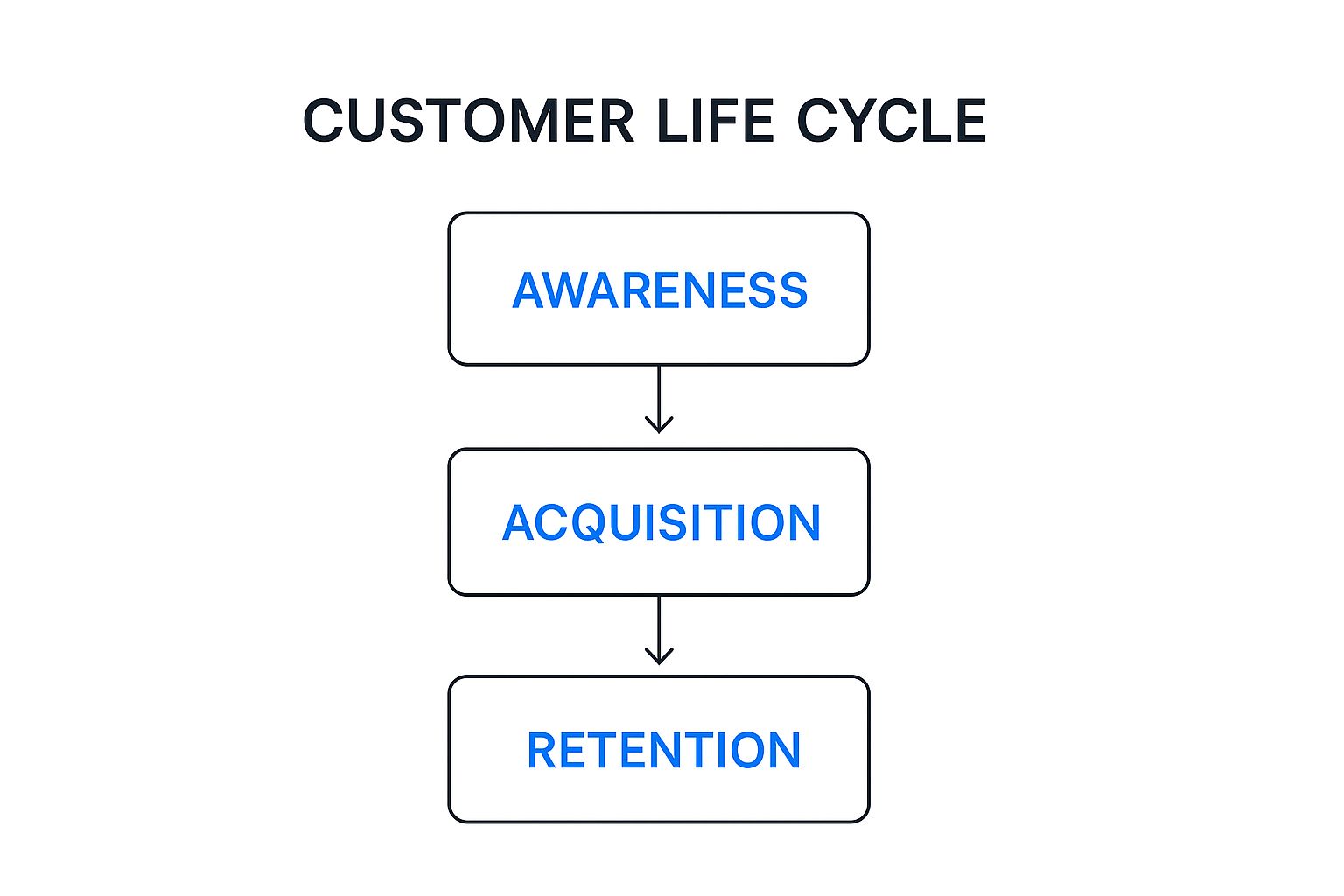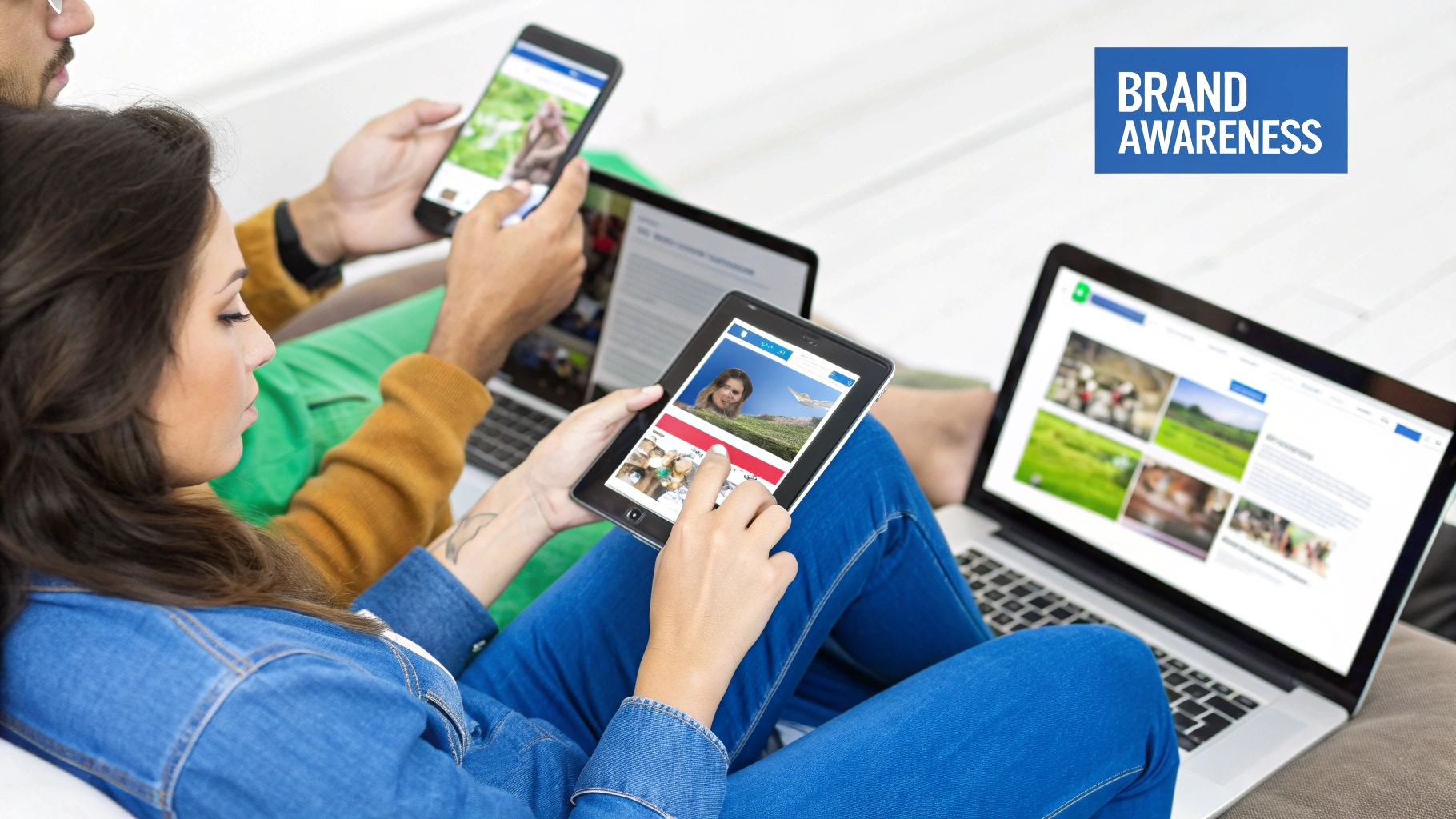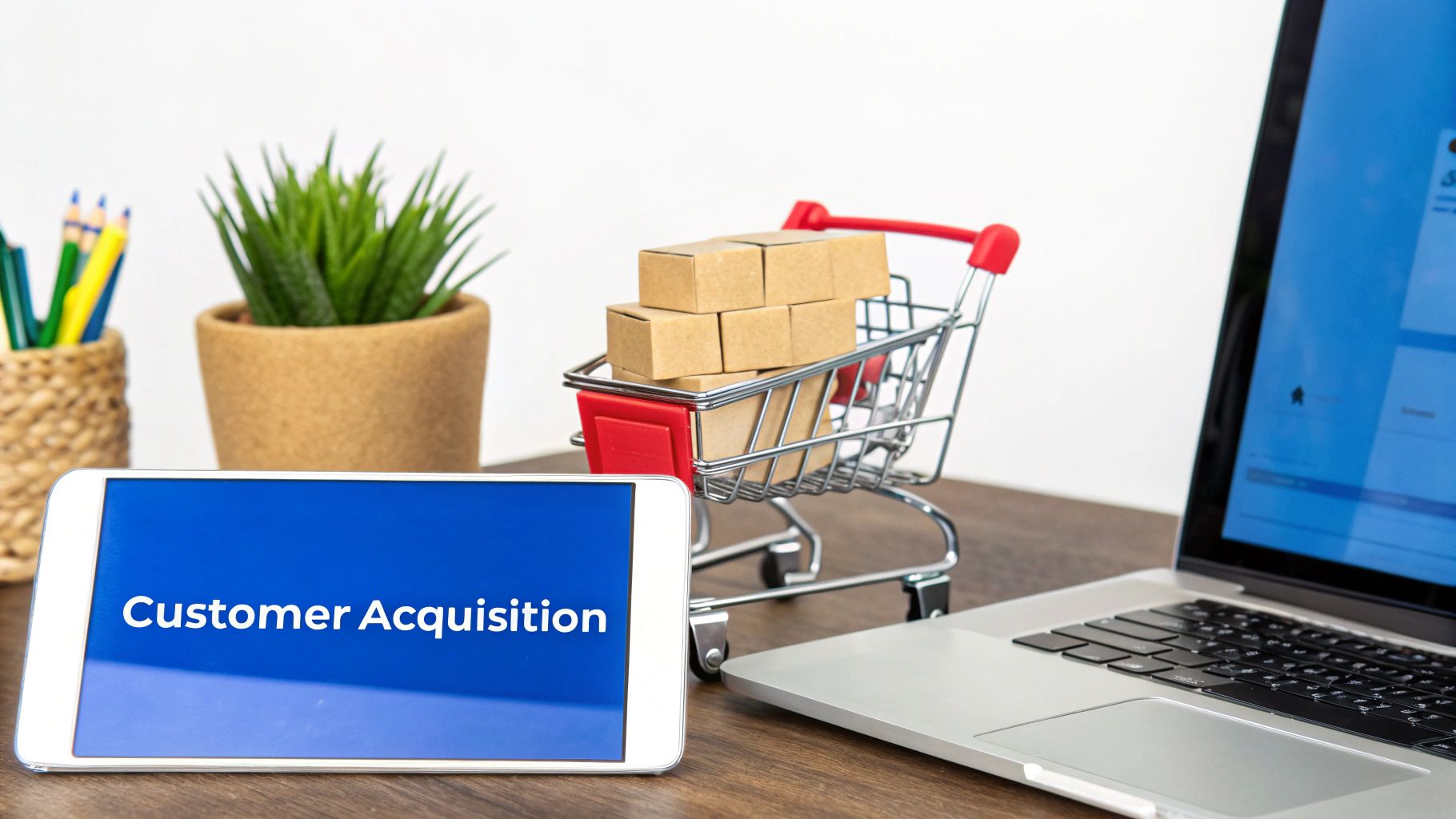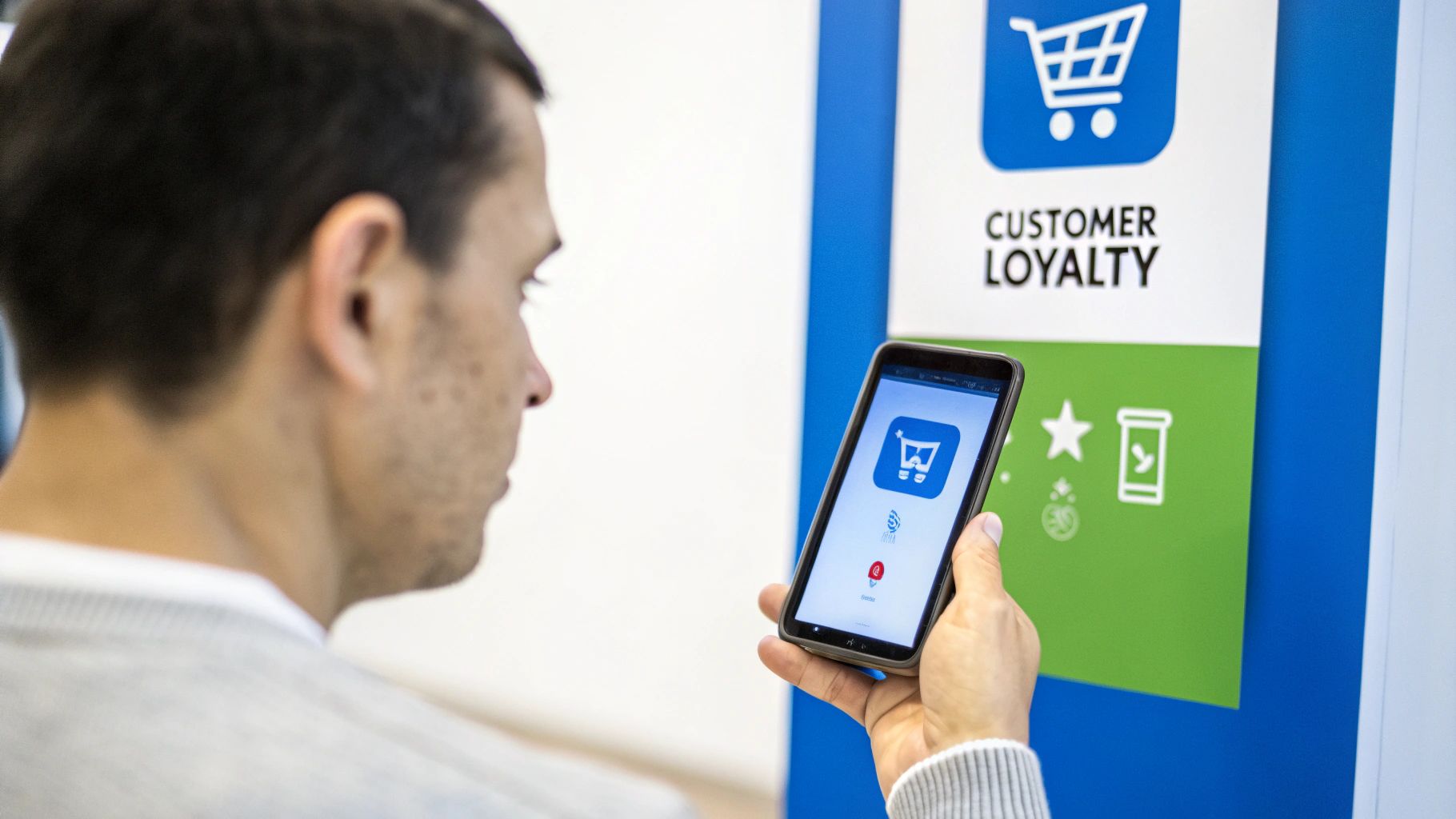The stages of the customer life cycle map out the entire path someone takes with your brand, from the moment they first hear about you to the point where they're recommending you to friends. This isn't just another sales funnel; it's a practical blueprint for building profitable, long-term relationships with every customer who comes your way.
Think of the customer life cycle like building any real relationship. It doesn't happen all at once. It starts with an introduction, moves through a phase of getting to know each other, leads to a commitment, and, if you play your cards right, blossoms into a true partnership where everyone wins. Rushing this process is like asking for marriage on a first date—it’s a recipe for failure.
Mapping this journey is absolutely critical for sustainable growth. It helps you meet customers where they are with the right message at the right time, ensuring you invest your resources wisely. Instead of just chasing one-off sales, you're building a reliable system that generates predictable revenue and creates genuine fans of your brand.
The journey is typically broken down into five key stages: Awareness, Consideration, Purchase, Retention, and Advocacy. This progression covers the whole experience, from a person's first inkling about your product to them becoming one of your most vocal supporters.
This visual gives you a clear picture of how customers flow from that initial spark of awareness to becoming a loyal, retained part of your business.

As you can see, successful marketing isn't just about getting new people in the door. It’s about a systematic process of guiding them toward lasting loyalty.
To make this even clearer, let's break down the core objective at each step.
This table provides a quick summary of each stage in the customer life cycle, outlining the main objective for the business at each step.
Each of these stages requires a different approach, and understanding that is the first step toward mastering the entire cycle.
Getting a handle on these stages brings focus and clarity to your entire marketing and sales strategy. It helps you answer the tough questions that actually drive growth:
By viewing the customer relationship as a continuous cycle rather than a linear funnel, businesses can shift from a transactional mindset to a relational one, which is the foundation of long-term success.
To get started on visualizing this process for your own business, you can use a comprehensive customer journey mapping template. Once you have your map, the next step is measurement. You can learn more about how to track customer journey attribution with the right tools.
The rest of this guide will break down each stage in detail, giving you the specific metrics and strategies you need to master the complete customer life cycle.

This is where it all starts—the first "hello." The Awareness stage is that initial moment a potential customer stumbles upon your brand for the very first time. Think of it like hosting a party. Your goal isn't just to get a crowd; it's to send out invitations that bring the right people through the door.
In a marketplace overflowing with noise, just being there isn't enough. You have to be seen. But more importantly, you need to be seen by the people who are most likely to need what you offer. It's about placing your brand right where your ideal audience is already hanging out, not just shouting into the void and hoping someone hears you.
Getting your name out there isn't about blasting your message everywhere. It’s about precision. A smart awareness strategy focuses on the channels where your audience actually lives, works, and plays online. This usually means a mix of tactics, all working together to maximize your reach without burning through your budget.
Here are a few of the most reliable channels for building awareness:
To get the most out of these efforts, you need to understand the role each plays. Digging into the fundamentals of different performance marketing channels will help you build a more cohesive and effective strategy.
How do you measure something as fuzzy as "awareness"? You can, and you must. Without tracking the right key performance indicators (KPIs), you're just guessing.
The goal at this stage isn't direct sales—it's about getting on the radar. Success is measured by how well you introduce your brand to new, relevant audiences and whether you make a memorable first impression.
You need to track the metrics that prove your brand's visibility is actually growing.
Top Awareness KPIs to Monitor
This early stage is where a platform like Cometly becomes invaluable. By tracking every touchpoint—starting from that very first ad click or website visit—Cometly connects your marketing spend to real-world results.
You can finally see which social media campaigns are actually driving new, qualified traffic or which blog posts are leading to those first brand searches. This data gives you the confidence to double down on what’s working, ensuring your first impression is not just powerful, but profitable.
Once you’ve grabbed someone’s attention, the real relationship-building begins. This is the Consideration stage. It’s that crucial time when potential customers know you exist and start actively figuring out if you’re the right choice for them.
Think of it like dating. You wouldn’t propose on the first date, right? Similarly, you can’t push for a sale right after a single ad click. This part of the customer journey is all about building trust and proving your worth. Your goal is to be a helpful guide, not just another salesperson shouting into the void. People are doing their homework—researching, comparing you to competitors, and looking for solid proof that you understand their problems. Your job is to be the one who provides the answers.
Effective nurturing is a mindset shift. It’s less about your product and more about your customer's problems. When you offer up genuine solutions and useful insights, you build credibility long before you ever ask for a credit card. This is where your content strategy really shines, helping you forge a connection one helpful resource at a time.
Here are a few powerful ways to do it:
This stage is won by the brands that give the most value. When you consistently help your audience solve their problems, you become the obvious choice when they are finally ready to buy.
By focusing on education instead of a hard sell, you build a foundation of trust. This makes the eventual purchase feel less like a transaction and more like the logical next step.
So, how do you know if all this nurturing is actually working? You have to look past vanity metrics like impressions and focus on actions that signal real, genuine interest. These are the KPIs that tell you who is leaning in and seriously considering what you have to offer.
Key Consideration Stage Metrics
As you guide people through the consideration phase, personalization is your secret weapon. Generic, one-size-fits-all messages are easy to ignore. Tailored communication, on the other hand, makes people feel seen and understood. In fact, one study found that 76% of consumers are more likely to buy from brands that personalize their experience.
This doesn't have to be overwhelmingly complicated. It can start with simple, smart actions, like segmenting your email list based on a guide someone downloaded. Or, you could retarget them with an ad that directly relates to the specific service page they just visited. The key is to automate these personal touchpoints. You can map out these interactions and create a more custom experience using a journey builder.
This is where a platform like Cometly brings incredible clarity. It connects the dots between the webinar someone attended last week and the pricing page they’re looking at today. By tracking these multi-touch journeys, you can finally see which nurturing activities—that specific email sequence, that one case study—are actually effective at moving people closer to a decision. This lets you stop guessing and start refining your strategy based on what truly builds trust.

This is the moment of truth. All your awareness campaigns, nurturing emails, and slick ads have led to this point: the Purchase Stage. This is where a genuinely interested prospect finally pulls out their wallet and becomes a paying customer. It’s where interest officially turns into revenue, and the entire customer relationship hinges on making this step as easy and reassuring as possible.
Think of it as the last few feet of a climb. Your customer has done all the hard work to get there, but one loose rock can make them second-guess the entire journey. At this stage, they are ready to buy, but any friction, confusion, or last-minute doubt can cause them to abandon the effort. Your job is to clear the path and give them a steady hand to the summit.
To turn that strong interest into a completed sale, you have to get inside the mind of the buyer. It's all about removing barriers and building a powerful sense of trust right when it counts the most. A clunky or confusing checkout process is probably the fastest way to lose a sale you already earned.
Here are a few proven tactics for creating a seamless purchase experience:
Even with a perfect process, some people will hesitate. Cart abandonment is just a part of e-commerce, but it doesn’t have to be the end of the story. With the right strategy, you can bring many of these almost-customers back to finish what they started.
This is where strategic retargeting comes in. By showing targeted ads to users who added items to their cart but never checked out, you can gently remind them of the great product they left behind. A timely follow-up email, maybe sweetened with a small discount, is often the exact nudge they need to cross the finish line.
The purchase stage isn't just a transaction; it's a critical trust-building exercise. A smooth, transparent, and reassuring process here sets the stage for a positive long-term relationship.
Getting this experience right is absolutely vital. After all, research shows that acquiring a new customer can cost five times more than retaining an existing one. On top of that, the probability of selling to an existing, happy customer is a whopping 60-70%, while the chance of selling to a brand new prospect is just 5-20%. These numbers show exactly why making that first purchase experience exceptional is so critical for future growth. You can explore more on the economic impact of the customer lifecycle on mailmunch.com.
To know if you're succeeding at this crucial point, you have to watch the numbers that directly reflect your ability to convert a browser into a buyer. These metrics tell the real story of how effective your checkout and sales strategies truly are.
Top Purchase Stage KPIs to Monitor
With a platform like Cometly, you get perfect clarity on these metrics. It connects every single ad click and email open to the final sale, showing you exactly which campaigns are bringing in high-value customers with a low CAC. That kind of data lets you fine-tune your ad spend, refine your checkout flow, and make smart decisions that directly improve your bottom line.

The sale isn’t the finish line. Far from it. It's the starting block for the real relationship.
The Retention Stage is where great brands separate themselves from the merely good ones. It’s all about obsessing over what happens after the purchase. This is your chance to turn a one-time buyer into a loyal, repeat customer who feels genuinely valued.
Think of it like being a great restaurant. Getting someone in the door for dinner is one thing. But it’s the incredible food, the attentive service, and the perfect ambiance that make them book their next reservation before they even leave. In your business, this post-purchase experience is how you prove to your customers that they made the right choice.
Pouring your energy into retention isn't just a nice-to-have; it's one of the most profitable investments you can possibly make. The numbers don't lie: acquiring a new customer consistently costs more than keeping one you already have.
When you deliver an outstanding experience after the sale, you’re building a stable, predictable revenue stream. That’s the engine for sustainable growth.
This is especially critical for subscription models. SaaS companies, for instance, live and die by retention. Their entire business model is built around minimizing churn—the rate at which customers cancel. With average annual churn rates often landing between 5% and 10%, even a small improvement can have a massive impact on the bottom line.
Building true loyalty requires a deliberate, proactive approach. It’s not just about fixing problems when they pop up. It’s about creating a consistently positive experience that makes customers want to stick around.
Here are a few powerful strategies to get it right:
A great post-purchase experience does more than just satisfy a customer—it makes them feel like an insider. This sense of belonging is the foundation of true, long-lasting loyalty.
By focusing on these areas, you can systematically improve customer satisfaction and build a loyal following. For a deeper dive, check out our guide on 10 proven customer retention strategies for SaaS companies.
To really know if your efforts are paying off, you need to be tracking the right numbers. The metrics below give you a clear, stage-by-stage picture of your customer journey, showing you what’s working and where you need to improve.
Tracking these KPIs at each step provides the feedback loop you need to continuously optimize your strategy and build stronger customer relationships.
Understanding what truly keeps customers loyal means you have to see their entire story.
Cometly gives you that unified view of the customer journey, connecting the very first ad they clicked with all their subsequent purchases and interactions. This is huge. It lets you pinpoint your most valuable customer segments—the ones with the highest CLV—and see exactly which acquisition channels brought them to you.
Armed with that data, you can refine your marketing to attract more high-value customers from the start and make smarter decisions to keep them happy for the long haul.
This is where all your hard work truly pays off. The advocacy stage is the pinnacle of the customer lifecycle—it’s where you turn happy, repeat buyers into your most powerful marketing engine. These customers aren't just loyal; they're genuine brand champions who go out of their way to tell others about you, driving new business your way without you spending a single extra dollar on ads.
Think of it like this: retention is keeping a customer coming back. Advocacy is that same customer grabbing their friends and bringing them to the party with you. Their honest-to-goodness endorsement is infinitely more credible than any ad you could ever run. A recommendation from a trusted friend is pure gold, creating a powerful loop that sends high-quality prospects right back to the top of your funnel.
Advocacy doesn't just happen by accident. You have to intentionally build the pathways that encourage and reward customers for spreading the word. The goal is to make it incredibly easy—and compelling—for them to share their great experiences. This means being proactive and giving them the right tools and a little motivation to become your voice.
Here are a few powerful ways to build an army of brand advocates:
Advocacy isn't just another marketing channel. It's the ultimate proof that you’ve created something genuinely worth talking about. It’s loyalty in its highest form.
By creating these kinds of opportunities, you're giving your happiest customers a megaphone, turning their personal satisfaction into a measurable asset for your business.
So, how do you know if you’re creating real brand champions? You have to track the right numbers—metrics that go beyond purchases and measure how people feel and what they’re saying about you. These KPIs tell you who’s not just sticking around, but actively recruiting for you.
Key Advocacy Metrics to Watch:
This is where a tool like Cometly becomes essential. You can connect all these advocacy efforts directly to your bottom line. By tracking every referral link and coupon code, you can see precisely how much revenue your biggest fans are generating. This gives you the true ROI of your loyalty programs, allowing you to fine-tune your strategy and see its impact across the entire customer lifecycle.
Even with a solid grasp of the customer life cycle stages, a few questions always pop up. Let's dig into them to clear up any lingering confusion.
This is a great question, and the distinction is important.
Think of the customer life cycle as the high-level, predictable framework that every customer moves through: Awareness, Consideration, Purchase, and so on. It’s like the blueprint of a building, showing the foundational stages everyone passes.
The customer journey, however, is the unique, personal path an individual takes through that building. It's the collection of specific touchpoints and interactions they have along the way—the exact Facebook ad they clicked, the blog post they read, or the customer service call they made. One is the map, the other is the specific route taken.
While getting new customers feels like a big win, the Retention stage almost always delivers the highest return on investment.
Why? Because it costs far more to attract a brand-new customer than it does to nurture an existing one. Happy, loyal customers not only stick around, but they also tend to spend more over time. Pouring effort into retention creates a solid foundation of predictable revenue, which is the key to long-term, sustainable growth. A big part of understanding this is knowing how to calculate CLTV (Customer Lifetime Value).
Absolutely. The customer life cycle isn't just for big corporations with massive marketing departments.
A small business might not have the budget for a splashy awareness campaign, but they can completely dominate the retention and advocacy stages. Think about it: personalized service, genuine follow-ups, and building real relationships are things small businesses can do better than anyone. This creates a powerful competitive edge that money can't always buy.
Ready to get crystal clear on every stage of your customer life cycle? Cometly gives you the unified attribution you need to see every touchpoint, optimize where your money goes, and turn raw data into profitable decisions. Get started with Cometly today.
Learn how Cometly can help you pinpoint channels driving revenue.
.svg)
Network with the top performance marketers in the industry